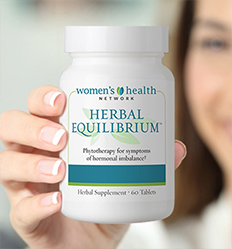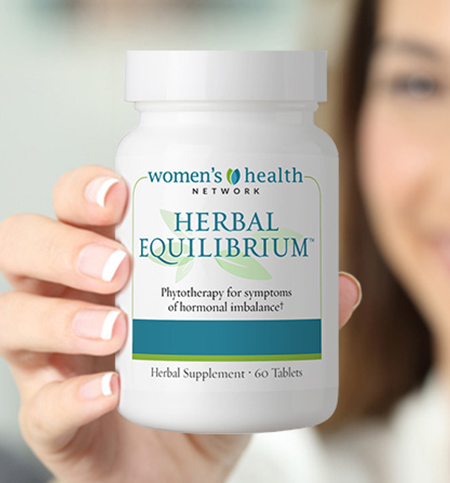Authored by Dr. Mary James, ND
At Women’s Health Network, we talk with many women who are frustrated with their medical care, especially when it comes to discussions of hormonal imbalance and hormone replacement therapy.

Women who are suffering from hot flashes, irritability, sleep disturbances, forgetfulness, anxiety, and more are often told that their hormones are “fine,” or they’re given prescriptions for hormone replacement therapy (HRT) or antidepressants, often without any discussion of drug risks or alternatives. Other women who are interested in HRT are confused about risks and benefits of synthetic hormones versus ‘bioidentical’ hormone therapy, but aren’t always getting their questions answered.
When something is off with our bodies, we want to talk it over with our healthcare practitioners. But if these conversations are discouraging or, worse, nonexistent, we’re left without the critically important information we need to feel better, and we don’t know where to turn for help. Our approach can help you foster a fruitful conversation with your doctor about hormone therapy and your alternatives.
Know where your doctor is coming from
Our goal is to help you find a health provider who will partner with you to create the best possible path through this potentially challenging period in your life, i.e., menopause. Remember that all healthcare providers are human. They have spent many years learning to be experts in their field and even more years practicing their expertise. They went into medicine to help people, but are also overstressed these days by managed care rules, financial considerations, and having to work as quickly as possible. He or she probably also did not get much training in sex hormones (female or male). (Only recently have many hospitals even started women’s health programs.)
We also want to help you understand the complexities of hormone therapy. HRT is still the gold standard for treating menopausal symptoms. However, HRT has been the subject of wide debate since the 1970s, and your doctor may be just as confused as you are. Both media headlines and drug companies have bombarded doctors with conflicting arguments about HRT and alternatives. Many practitioners are still wary of prescribing hormone therapy ever since large studies like the Women’s Health Initiative reported increased risks of breast cancer, coronary heart disease, stroke and venous thromboembolism in menopausal women using conventional HRT. “Bioidentical” hormones are made from plants and match the chemical structure of your own hormones. Although bioidentical HRT is safer in many ways than conventional HRT, most doctors don’t have experience with it, or they simply place more trust in synthetic hormones because they’ve been so thoroughly tested.
Is hormone therapy dangerous or not?
Many different factors determine the risk/benefit ratio in menopausal women using HRT. Some of these factors have to do with the hormones themselves. Various effects of HRT can depend on:
- the form of the hormones (synthetic versus bioidentical)
- the route of administration (oral versus topical, or transdermal)
- the dosage
- the length of treatment
Conventional HRT typically consists of “conjugated equine estrogens,” or CEEs (e.g., Premarin) and – if a woman still has her uterus – medroxyprogesterone acetate, or MPA (e.g., Provera); the combination of the two is called Prempro. CEEs are made from pregnant mares’ urine; hence, they’re natural to horses but not to us! CEEs are also much more likely than bioidentical hormones to break down into an compound that damages DNA in breast tissue. MPA is given along with estrogens to protect a woman’s uterus. However, it’s entirely synthetic and is responsible for much of the disease risk that has been observed in women using conventional HRT. Because CEEs and MPA are taken orally, they must first travel to your liver where they can activate pro-coagulation proteins, increasing the risk of clot formation, ischemic stroke and thromboembolism. This doesn’t happen with transdermal hormones, since they bypass the liver.
Because we’re all unique in terms of our genetic make-up and individual health problems and risks, the typical one-size-fits-all approach to HRT is asking for trouble. Individual factors that can influence the safety of HRT include:
- Your age
- Your weight and body mass index (BMI)
- Family history, e.g., of breast cancer or cardiovascular disease
- Genetic susceptibilities
- Environmental stressors
- Alcohol intake
Are you beginning to see why the question of whether to use HRT or not a simple one? Ideally, your healthcare practitioner will fully evaluate your unique set of risk factors, including genetic make-up, environmental factors, and underlying health problems that might make HRT more risky (e.g., breast cancer risk) or more helpful (e.g., osteoporosis prevention). If you decide to use HRT, the safest forms and doses should be used, and you should be regularly monitored over time for any emerging problems.
Know your body, your menopause symptoms and your medical history
We suggest assessing your symptoms to figure out what’s bothering you most before visiting your doctor. Your worst symptom may be insomnia, moodiness, hormonal weight gain, hot flashes, or something else. Doctors are taught to first ask for a patient’s “chief complaint,” then take a history — when, what, how, where, etc. Unfortunately, with managed care time constraints, a full discussion often fails to take place. So, be prepared and you’ll get more out of the visit.
Here’s some information to gather prior to your appointment:
- A list of your symptoms, with the most bothersome at the top
- Your own past medical history and your family medical history
- A list of your prescriptions and supplements
- Notes about your ideal approach to menopausal symptoms, and what feels realistic for your life (i.e., Do you like to take a more natural approach to your health? Are you willing to make changes in your diet and in your lifestyle? Are you interested in bioidentical hormones?)
When you are ready to call for your appointment, specifically request a “hormone consultation.” Ask for an appointment of at least 15 to 30 minutes. Having a “hormone consultation” should be the sole focus of your visit, and you deserve to stay comfortably dressed in your clothes instead of having to wear a “johnnie” and sit on an exam table. Be sure to schedule your check-up after the consultation, or on another day, if necessary. This type of focused consultation appointment makes it easier to say what you want to say without being rushed or distracted by other topics.
Know what you are asking for — options for menopause symptom relief
We encourage you to do some research on your choices prior to meeting with your healthcare provider. The chart below lists the pros and cons of some of your options for menopausal symptom relief. If you’d like more detail on large hormone studies, please see our article Findings on HRT since the Women’s Health Initiative.
What it is Conventional HRT?
Conventional HRT usually consists of Premarin (conjugated equine estrogens, or CEEs); Provera (medroxyprogesterone acetate, or MPA — a synthetic progestin); and Prempro (a combination of Premarin and Provera).
| Pros | Cons |
|
|
What it is Bioidentical HRT?
Hormones made from plants to match the exact chemical structure of your body’s hormones (e.g., Prometrium, Estrace, Estraderm, Climera).
| Pros | Cons |
|
|
What are single herb remedies?
Some common single-herb menopause remedies include: black cohosh, red clover, soy, dong quai, and evening primrose oil.
| Pros | Cons |
|
|
What are multi-botanical remedies?
Multi-botanical remedies generally include more than one herb. For example, our Herbal Equilibrium includes: black cohosh, red clover, kudzu, passionflower, chasteberry, wild yam and ashwagandha.
| Pros | Cons |
|
|
What are diet and lifestyle changes?
Hormonal balance is improved by include adding protein to every meal, cutting back on sugar and alcohol, adding more vegetables, taking a multivitamin/mineral, getting enough sleep, and carving out more regular time for relaxation and self-reflection.
| Pros | Cons |
|
|
Feeling your best usually takes more than just a prescription. We recommend trying the most natural, least invasive steps first to create a foundation of health and hormonal balance, and then gradually adding remedies, as needed. We formulated Herbal Equilibrium to help balance estrogen, progesterone and testosterone and to relieve the top 10 symptoms of menopause. For a more comprehensive approach, our Hormonal Health Program includes a hormone-healthy diet and lifestyle guide (with recipes!), a rich multivitamin, Omega-3 fatty acids, Herbal Equilibrium, free phone support and exclusive webinars. We also have a program to help women wean themselves off of HRT. No matter what you choose, you have support from Women’s Health Network.
L’Hermite M. HRT optimization, using transdermal estradiol plus micronized progesterone, a safer HRT. Climacteric. 2013 Aug;16 Suppl 1:44-53.
Rossouw JE, Anderson GL, Prentice RL, et al. Risks and benefits of estrogen plus progestin in healthy postmenopausal women: principal results From the Women’s Health Initiative randomized controlled trial. JAMA. 2002 Jul 17;288(3):321-333. Article available at: https://jama.jamanetwork.com/article/?articleid=195120
L’Hermite M. HRT optimization, using transdermal estradiol plus micronized progesterone, a safer HRT. Climacteric. 2013 Aug;16 Suppl 1:44-53.
Bolton JL, Thatcher GR. Potential mechanisms of estrogen quinone carcinogenesis. Chem Res Toxicol. 2008 Jan;21(1):93-101.
L’Hermite M. HRT optimization, using transdermal estradiol plus micronized progesterone, a safer HRT. Climacteric. 2013 Aug;16 Suppl 1:44-53.
Rossouw JE, Anderson GL, Prentice RL, et al. Risks and benefits of estrogen plus progestin in healthy postmenopausal women: principal results From the Women’s Health Initiative randomized controlled trial. JAMA. 2002 Jul 17;288(3):321-333. Article available at: https://jama.jamanetwork.com/article/?articleid=195120
Davey DA. Update: estrogen and estrogen plus progestin therapy in the care of women at and after the menopause. Womens Health (Lond Engl). 2012 Mar;8(2):169-189.
Rossouw JE, Anderson GL, Prentice RL, et al. Risks and benefits of estrogen plus progestin in healthy postmenopausal women: principal results From the Women’s Health Initiative randomized controlled trial. JAMA. 2002 Jul 17;288(3):321-333. Article available at: https://jama.jamanetwork.com/article/?articleid=195120
L’Hermite M. HRT optimization, using transdermal estradiol plus micronized progesterone, a safer HRT. Climacteric. 2013 Aug;16 Suppl 1:44-53.
Fournier A, Berrino F, Riboli E, et al. Breast cancer risk in relation to different types of hormone replacement therapy in the E3N-EPIC cohort. Int J Cancer. 2005 Apr 10;114(3):448-454.












